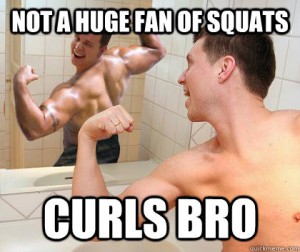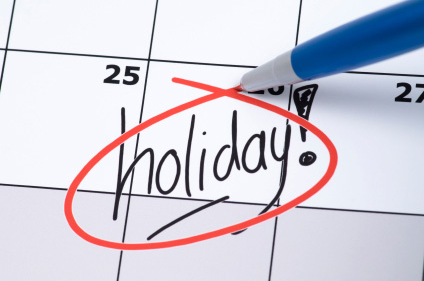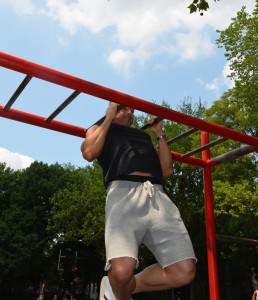Ebb and flow
to decrease and then increase, as with tides; a decrease followed by an increase, as with tides.
It’s shortly before noon on a sunny Wednesday afternoon. Late morning is prime training time for me as the gym is relatively quiet. The half-asleep Manhattan pre-work crowd has long since shuffled off and the lunch time heroes have yet to arrive, leaving just a handful of bored trainers talking shop and the occasional silicone-enhanced trophy MILF lightly perspiring on the treadmill.
But I’m not at the gym. I’m not lifting today, nor am I hitting a martial arts class. In fact, I’m skipping the gym and dojo entirely this week, opting instead to knock off a list of much-needed errands, and as a result do some extra walking around NYC.
No, I haven’t turned in my bro badge nor have I filed my meathead retirement papers. It’s just that my recent fat loss phase was particularly long and consumed a lot of my time and focus.

So I’m taking a break from the iron, and considering the pile of work on my desk (not to mention my impending move) I might just extend the sabbatical to two weeks or even three.
And I’m perfectly okay with that.
Why Break?
I’m a big believer in taking regular scheduled breaks from intense, structured resistance training.
Now read that last sentence again because the proverbial devil is definitely in the details.
“Regularly scheduled breaks” refers to training breaks planned long in advance; not waking up one afternoon in a strange Las Vegas bedroom in a Hunter S. Thompson-inspired daze and declaring that this would be a swell week for a training hiatus, not to mention a serious lifestyle intervention.
“Intense structured resistance training” means just that – a hard, structured weight training program that builds in volume and intensity, thereby forcing your body to adapt.
It’s 12 weeks of never missing a workout and smashing PR’s or stripping off bodyfat, not lifting on a Monday, being so sore that you can’t sit on the toilet til Thursday, and then opting to take the following week off to “fully recover.”
In other words, you gotta earn these breaks. And the payoff for taking much-needed time off isn’t just catching up on HBO.
The Big Payback
Joint Health – Intense weight training beats the hell out of your body. Even if you use near perfect form (something I recommend; apologies to Crossfit) you’re still exposing your tendons, joints, and connective tissue to considerable stress — especially if you’re strong.
Pain starts to manifest when your body can’t regenerate fast enough to keep up with the daily the wear and tear you’re subjecting it to. Now factor in that your Wolverine-like recuperative abilities starts to decline after 30 and you have the makings of the next Aleve campaign.
However, I find that sometimes as little as 5 days off can significantly reduce cranky elbows or bitchy knees. #CantAffordHGH
Mental Health – Training with weights is fun. But doggedly fighting your logbook is mentally taxing. Even very successful 16 week training blocks will still have a few missed lifts and piss poor workouts, while less noteworthy phases can involve deep plateaus.
It’s frustrating and exhausting and can at times make you long for the days when you used to just show up and pump pecs and arms like a Friday night douchebag. An extended break can help re-center you mentally.

Evaluate –It’s not until you come out the other end of a training program that you can objectively assess whether it was even successful. Not to mention, for supercompensation to occur a decrease in volume and intensity is required.
Get Other Stuff Done – I don’t care how hard you have your schedule on lock down, once you start hitting two a days, things like work, hobbies, even family invariably take a hit. Regular time off allows other easy to neglect areas of your life to catch up.
Re-Focus – At times we can find ourselves working out without a purpose. Weeks of training can stretch into months, programs get extended, and the daily trip to the gym becomes just another habit, like brushing your teeth. You simply go through the motions.
Then you take a week off and quickly realize just how much satisfaction training brings to your life. And it’s way beyond just the physical. For that reason I often have my best lifting after a few days off.
The Layoff FAQ

What should I do with the extra time in my day?
I don’t know. Stuff? Specifically stuff away from the gym. Activities involving family, friends, and travel is never a bad idea, or in my case, long-ass writing projects or removing the sleeves off of t-shirts.
I keep a note on Evernote I cheekily call Random Shit – it’s thoughts and ideas that pop into my head that I may want to take a closer look at once I have more free time.
Along with blog post ideas, training topics, and 90’s rap lyrics, it has tasks I want or need to do when I get a spare moment (i.e., clean office, give away shoes, etc.) An off-week is as good a time as any to pare this list down a bit.
I feel awesome. Won’t I lose progress if I take a break?
Look, if you feel awesome then keep training. Just be sure to take a de-load every month (50% reduction in volume, 20% reduction in intensity) or so or you’ll be in line for a long holiday quicker than you think.
However, if you feel physically drained or unmotivated — or in my case, just psychologically overwhelmed by all the other stuff going on in your life — then consider taking a break. Your heroics aren’t helping.
Aren’t layoffs three steps forward, two steps back?
The amount of muscle you gain in a week is miniscule, as is the amount you might lose in a week or even two weeks of relative inactivity. But what you might gain after a short break in terms of motivation and restoration is significant. For that reason, specific training breaks are among the most effective restoration tactics.
Interestingly, once guys get strong (or celebrate their 35th birthday), they quickly learn that no training is usually better than shitty training.
Won’t I get fat if I take time off?
If you train just to able to eat more, well let’s just say you’re screwing this here lifestyle up.
This is a problem I see with a lot of journeyman fitness types – they use exercise strictly as a means to burn off whatever they happen to be eating.
It reduces food to simply “fuel” and exercise to just “calorie expenditure.” It also doesn’t work well, especially trying to quantify the “calories expended” side of the equation.
While calories obviously count, any sensible person can see how this is a narrow-minded approach to nourishing your body. That said, I have some dietary recommendations below.
How should I eat during a break?
Since you’re not training, my best advice is to eat how you normally eat, just maybe smaller portions and less frequently, while perhaps including some things you might be craving as a treat.
Fine advice I know, but for some this is akin to the “just put the tip in” philosophy of birth control.
Here’s the thing: for many, the rigid structure of the Fitness Pro’s Diet allows them to maintain a false sense of “control.”
The irony is it’s really this super strict structure that controls them.
This becomes evident when you remove the rigid meal frequency paradigm while giving the green light to include some “junk” — suddenly they’re like horny sailors on dietary shore leave, doubling up on fast food or polishing off pints of Ben & Jerry’s.
I’m not a psychologist or a licensed therapist – neither are 99% of the fitness writers who offer “advice” in this complex area. In fact, many fitness pros have unresolved or undiagnosed food issues themselves and are the last ones who should be taking on the role of internet therapist.
All I can responsibly say is that it behooves you to develop a deep understanding for what works for you and more importantly, what might “set you off.”
And I can certainly relate. In the past, if I was on a break and allowed myself a few too many indulgences, I easily fell victim to the “all or nothing” or “ahh fuck it” line of thinking.
If you’ve ever heard (or said) “I’ll eat better once I get back to the gym next week” then you know what I mean.
This was magnified if I was travelling or surrounded by new and tasty foods, especially an impressive drink menu. I’ve always liked to have a good time (still do) and can be a tad impulsive (still am), and let’s just say things can escalate rather quickly if I let my inner teenager call the shots, as it did last week.
Game

Set

Match

Fortunately for everyone involved, like my long-suffering wife, these occasions don’t come up too terribly often anymore.
What I’ve learned is that while on break I should try to keep my protein intake relatively high throughout the day and reserve most of my carb and alcohol indulgences for the last few hours before bed.
This limits the number of hours that I can do “damage,” while the extra carbs and booze also helps facilitate sleep, which starts to suffer when I’m not training regularly.
When should I go back?
The short answer is a week and/or once your shit is done. But a better answer is once you’re chomping at the bit to resume. Come back after just a day or two and you don’t gain much restoratively; stay away too long and actual de-training can start to occur. For me 5-7 days is about perfect. By then I’m dying to get under the bar.
How often should take breaks?
This depends on how old you are, how beat up you are, how hard you train, and how well you take care of yourself the rest of the time in terms of restorative practices. (This is huge for guys over 40!)
Excluding deloads, a hard training guy in his 20’s should take 1 week off completely every 4 months; guys over 30, 1 week off every 3 months; and guys over 40 might need 1 week off every 8 weeks. Again, there is much room for variation here.
NOTE: I would be re-miss if I didn’t bring up monitoring HRV, or Heart Rate Variability. It’s a relatively new and very interesting way to monitor readiness to exercise by measuring waking pulse rate.
I plan to thoroughly test it out on myself this Fall and Winter; in the meantime, check out my colleagues Dr. Mike T Nelson and Dave Dellanave for some excellent info.
Can I workout at all on break?
Some guys just gotta lift. If it’s just a week off I think that’s a bad idea – go read a book or visit Tuscany or get a fricken lap dance, do something other than lift!
Seriously, I’d prefer you do things outside of the gym that raise your heart rate and challenge your athleticism to a degree rather than banging away at the weights. The mental benefits far exceed whatever minor improvements you might make under the bar.
But once you start talking two or three weeks off from lifting at a stretch I’m more in favor of doing some meaningful “pre-training” before your “real” training starts up again.
When faced with an extended lay off (as I am right now) what I like to do is use the time to address glaring “holes” in my game while avoiding areas that tend to get sore, inflamed, or otherwise jacked-up.
In my case, for the next few weeks I’m giving my poor shoulders and elbows a break while working on shoulder, hip, and thoracic mobility.
I’m not a mobility expert – I’m a look good naked kind of guy – but I think mobility work has value in specific, controlled doses. So I reached out to my colleague Dean Somerset for a mobility program based on my needs.
I do the following almost every day.
Hanging lat stretch with squat
This is a great warm-up for the lats and helps with scapular movement into overhead moves, while also working hamstrings and calves.
Find any solid object to hang off of, and make sure you’re sitting far enough back to get the shoulders to stretch out. Make sure your heels are on the floor and sit down as deep into a squat as possible, ensuring you don’t stop breathing.
Hang from your shoulders and then try to straighten your knees, keeping your spine straight and in line with your arms. Hold at the top for 2-3 seconds, then return back to a squat position.
Prone Elastic Shoulder Rotations
This is a great shoulder rotational warm up that allows for a wide range of motion for even very restricted shoulders like yours truly due to the flexibility of the band.
Lying on your stomach, lift your chest a few inches off the floor and keep your chin tucked towards your collarbone. With your arms straight and over your head, pull the band to put some slight tension into it, and keeping the elbows straight pull it back and down to your butt.
Return back to overhead and repeat. If you can, try to not drag the band along the back of your head, leaving a few inches between the two.
Goalie Stretch
This move gives your adductors some more range of motion and helps move you out of straight saggital plane movements and into some frontal plane stuff.
From a hands and knees position, try to open your knees as wide as possible, then either stay up on your hands or lower down to your elbows for a deeper stretch.
Once you’re at max or near max width, rock back and forth slowly and within your tolerance.
Half kneeling power rack shoulder strides
A power rack isn’t necessary — any upright pole that’s only a few inches deep would work well.
Get into a half kneeling position with your butt, shoulders, and head pressed back into the pole. Take a small dowel or stick and grab it in both hands so that it’s on the other side of the pole versus your body.
Slowly press the stick up and pull it down while on the other side of the pole to stretch the shoulders. Brace the core and make sure you’re breathing.
I also include a few mobility staples like wall slides, Cossack squats, split-stance adductor mobilizations, and plenty of pec and lat stretches with a mini-band. I also hold a rear-foot elevated quad and hip flexor stretch for 30 seconds per leg.
The Heavy
Next, 3 days a week, I follow the above drills with some specific exercises.
A) Back Squats. 6 x 6 reps. Along with a hip-hinge, a good squat groove is the most valuable skill you can develop. I don’t want to lose it, so I squat often.
I keep a slow, methodical tempo and focus on achieving excellent depth. The 6 x 6 scheme paired with 60 seconds rest gives a hell of a pump without the need for much weight. That said, I’ve still been squatting heavy once a week with my colleague Dan Trink, who thinks anything over 3 reps is cardio. Oh well.
B) Glute-Ham Raise – 5 x failure. Without question, my favorite posterior chain exercise during “off phases.”
C) Chest-supported Rows – 4 x 8. I hold for a full second in both the stretch and contract position, and emphasize scapular retraction at the start of the movement. Along with the mobility work above this just seems to straighten me out.
D) Prone Trap Raises – 3 x 8-10 reps.
E) Random Arms and Calves. Cause really, it’s what I do.
That’s it. Notice what I don’t do – benching, overhead presses, lateral raises, triceps extensions, dips, or chin-ups — great exercises, but if I hammer away at them too long they start to give me grief.
The Bigger Picture
Something sad happened in fitness. Back in the day, guys used to embrace the ebb and flow of the process. Three or four months before a contest would see them ramp up their training while eliminating any cheats and distractions along the way.
After the contest was over, however, most would relax and take a brief but well-deserved break, and in the process re-connect with family and friends and the other thousand things life has to offer.
Today, however, that’s not “hardcore.”
Even non-professionals are bragging about going balls out 24-7, eating like a “machine” 365 days a year, and doing selfish shit like skipping birthday parties for fear of being around “toxic fat people” when it’s really because they’re worried they might break down and sneak a piece of “unclean” ice cream cake.
I call the phenomenon Facebook Fitness and it’s immature and misguided, not to mention unnecessary.
Because 90 percent of the truly impressive physiques in the industry belong to those who “get it.”
They understand that the key to a lifetime of gym success lies in knowing when to go balls out, and when to just cruise for a while and enjoy the ride.


